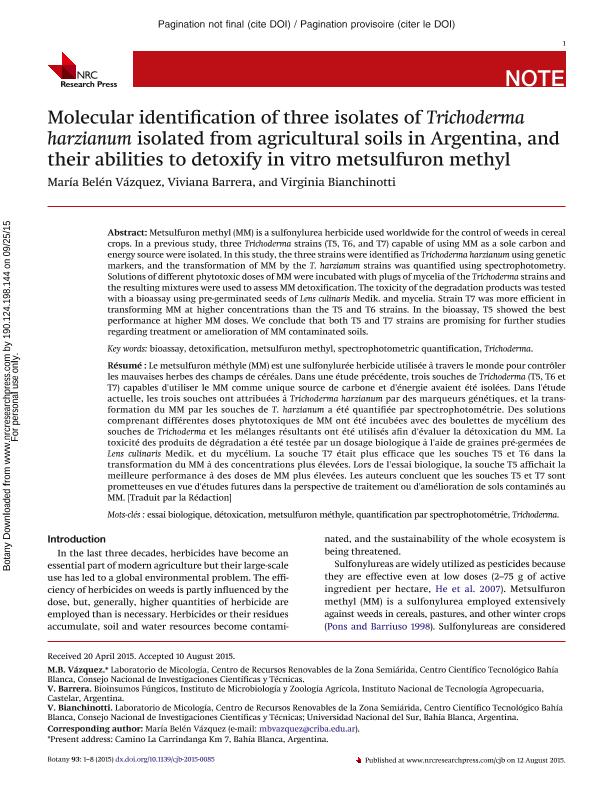Mostrar el registro sencillo del ítem
dc.contributor.author
Vazquez, María Belén

dc.contributor.author
Barrera, Viviana
dc.contributor.author
Bianchinotti, Maria Virginia

dc.date.available
2017-01-18T20:13:06Z
dc.date.issued
2015-11
dc.identifier.citation
Vazquez, María Belén; Barrera, Viviana; Bianchinotti, Maria Virginia; Molecular identification of three isolates of Trichoderma harzianum isolated from agricultural soils in Argentina, and their abilities to detoxify in vitro metsulfuron methyl; Canadian Science Publishing; Botany; 93; 11; 11-2015; 793-800
dc.identifier.issn
1916-2790
dc.identifier.uri
http://hdl.handle.net/11336/11590
dc.description.abstract
Metsulfuron methyl (MM) is a sulfonylurea herbicide used worldwide for the control of weeds in cereal crops. In a previous study, three Trichoderma strains (T5, T6, and T7) capable of using MM as a sole carbon and energy source were isolated. In this study, the three strains were identified as Trichoderma harzianum using genetic markers, and the transformation of MM by the T. harzianum strains was quantified using spectrophotometry. Solutions of different phytotoxic doses of MM were incubated with plugs of mycelia of the Trichoderma strains and the resulting mixtures were used to assess MM detoxification. The toxicity of the degradation products was tested with a bioassay using pre-germinated seeds of Lens culinaris Medik. and mycelia. Strain T7 was more efficient in transforming MM at higher concentrations than the T5 and T6 strains. In the bioassay, T5 showed the best performance at higher MM doses. We conclude that both T5 and T7 strains are promising for further studies regarding treatment or amelioration of MM contaminated soils.
dc.description.abstract
Le metsulfuron méthyle (MM) est une sulfonylurée herbicide utilisée a` travers le monde pour contrôler les mauvaises herbes des champs de céréales. Dans une étude précédente, trois souches de Trichoderma (T5, T6 et T7) capables d'utiliser le MM comme unique source de carbone et d'énergie avaient été isolées. Dans l'étude actuelle, les trois souches ont attribuées a` Trichoderma harzianum par des marqueurs génétiques, et la transformation du MM par les souches de T. harzianum a été quantifiée par spectrophotométrie. Des solutions comprenant différentes doses phytotoxiques de MM ont été incubées avec des boulettes de mycélium des souches de Trichoderma et les mélanges résultants ont été utilisés afin d'évaluer la détoxication du MM. La toxicité des produits de dégradation a été testée par un dosage biologique a` l'aide de graines pré-germées de Lens culinaris Medik. et du mycélium. La souche T7 était plus efficace que les souches T5 et T6 dans la transformation du MM a` des concentrations plus élevées. Lors de l'essai biologique, la souche T5 affichait la meilleure performance a` des doses de MM plus élevées. Les auteurs concluent que les souches T5 et T7 sont prometteuses en vue d'études futures dans la perspective de traitement ou d'amélioration de sols contaminés au MM. [Traduit par la Rédaction]
dc.format
application/pdf
dc.language.iso
eng
dc.publisher
Canadian Science Publishing
dc.rights
info:eu-repo/semantics/openAccess
dc.rights.uri
https://creativecommons.org/licenses/by-nc-sa/2.5/ar/
dc.subject
Bioassay
dc.subject
Detoxification
dc.subject
Metsulfuron Methyl
dc.subject
Spectrophotometric Quantification
dc.subject
Trichoderma
dc.subject.classification
Micología

dc.subject.classification
Ciencias Biológicas

dc.subject.classification
CIENCIAS NATURALES Y EXACTAS

dc.title
Molecular identification of three isolates of Trichoderma harzianum isolated from agricultural soils in Argentina, and their abilities to detoxify in vitro metsulfuron methyl
dc.type
info:eu-repo/semantics/article
dc.type
info:ar-repo/semantics/artículo
dc.type
info:eu-repo/semantics/publishedVersion
dc.date.updated
2017-01-17T19:20:30Z
dc.identifier.eissn
1916-2804
dc.journal.volume
93
dc.journal.number
11
dc.journal.pagination
793-800
dc.journal.pais
Canadá

dc.journal.ciudad
Otawa
dc.description.fil
Fil: Vazquez, María Belén. Consejo Nacional de Investigaciones Científicas y Técnicas. Centro Científico Tecnológico Bahía Blanca. Centro de Recursos Naturales Renovables de la Zona Semiárida(i); Argentina
dc.description.fil
Fil: Barrera, Viviana. Instituto Nacional de Tecnología Agropecuaria. Centro Nacional de Investigaciones Agropecuarias. Centro de Investigación de Ciencias Veterinarias y Agronómicas. Instituto de Microbiología y Zoología Agrícola; Argentina
dc.description.fil
Fil: Bianchinotti, Maria Virginia. Consejo Nacional de Investigaciones Científicas y Técnicas. Centro Científico Tecnológico Bahía Blanca. Centro de Recursos Naturales Renovables de la Zona Semiárida(i); Argentina. Universidad Nacional del Sur; Argentina
dc.journal.title
Botany

dc.relation.alternativeid
info:eu-repo/semantics/altIdentifier/url/http://www.nrcresearchpress.com/doi/10.1139/cjb-2015-0085#.WH_G5vnhCJA
dc.relation.alternativeid
info:eu-repo/semantics/altIdentifier/doi/http://dx.doi.org/10.1139/cjb-2015-0085
Archivos asociados
